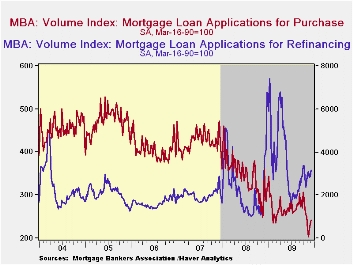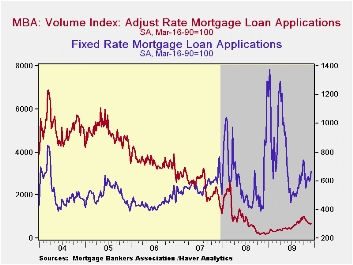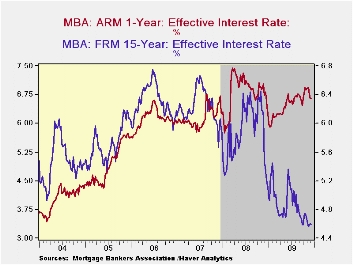 Global| Dec 09 2009
Global| Dec 09 2009U.S. Disposable Personal Income& Spending Continue Firm
by:Tom Moeller
|in:Economy in Brief
Summary
Low interest rates continue to support the housing market. The Mortgage Bankers Association reported that mortgage applications rose 8.5% last week, the second week of firm gain that continued what has been a 50% rise since the late- [...]
 Low
interest
rates continue to support the housing market. The Mortgage Bankers
Association reported that mortgage applications rose 8.5% last week,
the second week of firm gain that continued what has been a 50% rise
since the late-June low.
Low
interest
rates continue to support the housing market. The Mortgage Bankers
Association reported that mortgage applications rose 8.5% last week,
the second week of firm gain that continued what has been a 50% rise
since the late-June low.
 The
effective fixed
interest rate on conventional 15-year mortgages fell slightly last week
to 4.59%. That equaled the November low and was down from the June
average of 5.21%. For 30-year mortgages the rate ticked up last week to
5.12% from a November average of 5.06%. Rates reached a high
of 5.79% in early-June. Interest rates on fixed 15-year and 30-year
mortgages are closely correlated (near-90%) with the rate on 10-year
Treasury securities. Rates on adjustable one-year mortgages fell to
6.64% last week from a November average of 6.81%.
The
effective fixed
interest rate on conventional 15-year mortgages fell slightly last week
to 4.59%. That equaled the November low and was down from the June
average of 5.21%. For 30-year mortgages the rate ticked up last week to
5.12% from a November average of 5.06%. Rates reached a high
of 5.79% in early-June. Interest rates on fixed 15-year and 30-year
mortgages are closely correlated (near-90%) with the rate on 10-year
Treasury securities. Rates on adjustable one-year mortgages fell to
6.64% last week from a November average of 6.81%.
 During the
last twelve months, the number of fixed-rate mortgage applications has
fallen by 21.5% and adjustable-rate mortgage applications have risen by
two and one-half times.
During the
last twelve months, the number of fixed-rate mortgage applications has
fallen by 21.5% and adjustable-rate mortgage applications have risen by
two and one-half times.
| MBA Mortgage Applications (SA, 3/16/90=100) | 12/04/09 | 11/27/09 | Y/Y | 2008 | 2007 | 2006 |
|---|---|---|---|---|---|---|
| Total Market Index | 665.6 | 613.7 | -18.6% | 642.9 | 652.6 | 584.2 |
| Purchase | 241.5 | 232.3 | -19.4 | 345.4 | 424.9 | 406.9 |
| Refinancing | 3,185.9 | 2,866.4 | -18.4 | 2,394.1 | 1,997.9 | 1,634.0 |
| 15-Year Mortgage Effective Interest Rate (%) | 4.59% | 4.60% | 5.24% (12/08) | 5.9% | 6.2% | 6.3% |
Tom Moeller
AuthorMore in Author Profile »Prior to joining Haver Analytics in 2000, Mr. Moeller worked as the Economist at Chancellor Capital Management from 1985 to 1999. There, he developed comprehensive economic forecasts and interpreted economic data for equity and fixed income portfolio managers. Also at Chancellor, Mr. Moeller worked as an equity analyst and was responsible for researching and rating companies in the economically sensitive automobile and housing industries for investment in Chancellor’s equity portfolio. Prior to joining Chancellor, Mr. Moeller was an Economist at Citibank from 1979 to 1984. He also analyzed pricing behavior in the metals industry for the Council on Wage and Price Stability in Washington, D.C. In 1999, Mr. Moeller received the award for most accurate forecast from the Forecasters' Club of New York. From 1990 to 1992 he was President of the New York Association for Business Economists. Mr. Moeller earned an M.B.A. in Finance from Fordham University, where he graduated in 1987. He holds a Bachelor of Arts in Economics from George Washington University.






